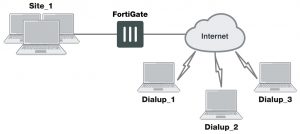FortiClient dialup-client configurations
The FortiClient Endpoint Security application is an IPsec VPN client with antivirus, antispam and firewall capabilities. This section explains how to configure dialup VPN connections between a FortiGate unit and one or more FortiClient Endpoint Security applications.
FortiClient users are usually mobile or remote users who need to connect to a private network behind a FortiGate unit. For example, the users might be employees who connect to the office network while traveling or from their homes.
For greatest ease of use, the FortiClient application can download the VPN settings from the FortiGate unit to configure itself automatically.
The following topics are included in this section: Configuration overview
- FortiClient-to-FortiGate VPN configuration steps
- Configure the FortiGate unit
- Configure the FortiClient Endpoint Security application
- Adding XAuth authentication
- FortiClient dialup-client configuration example
Configuration overview
Dialup users typically obtain dynamic IP addresses from an ISP through Dynamic Host Configuration Protocol (DHCP) or Point-to-Point Protocol over Ethernet (PPPoE). Then, the FortiClient Endpoint Security application initiates a connection to a FortiGate dialup server.
By default the FortiClient dialup client has the same IP address as the host PC on which it runs. If the host connects directly to the Internet, this is a public IP address. If the host is behind a NAT device, such as a router, the IP address is a private IP address. The NAT device must be NAT traversal (NAT-T) compatible to pass encrypted packets (see Phase 1 parameters on page 1624). The FortiClient application also can be configured to use a virtual IP address (VIP). For the duration of the connection, the FortiClient application and the FortiGate unit both use the VIP address as the IP address of the FortiClient dialup client.
The FortiClient application sends its encrypted packets to the VPN remote gateway, which is usually the public interface of the FortiGate unit. It also uses this interface to download VPN settings from the FortiGate unit. See Automatic configuration of FortiClient dialup clients on page 1703.
Example FortiClient dialup-client configuration
Peer identification
The FortiClient application can establish an IPsec tunnel with a FortiGate unit configured to act as a dialup server. When the FortiGate unit acts as a dialup server, it does not identify the client using the Phase 1 remote gateway address. The IPsec tunnel is established if authentication is successful and the IPsec security policy associated with the tunnel permits access. If configured, the FortiGate unit could also require FortiClient registration, that is, the remote user would be required to have FortiClient installed before connection is completed.
Automatic configuration of FortiClient dialup clients
The FortiClient application can obtain its VPN settings from the FortiGate VPN server. FortiClient users need to know only the FortiGate VPN server IP address and their user name and password on the FortiGate unit.
The FortiGate unit listens for VPN policy requests from clients on TCP port 8900. When the dialup client connects:
- The client initiates a Secure Sockets Layer (SSL) connection to the FortiGate unit.
- The FortiGate unit requests a user name and password from the FortiClient user. Using these credentials, it authenticates the client and determines which VPN policy applies to the client.
- Provided that authentication is successful, the FortiGate unit downloads a VPN policy to the client over the SSL connection. The information includes IPsec Phase 1 and Phase 2 settings, and the IP addresses of the private networks that the client is authorized to access.
- The client uses the VPN policy settings to establish an IPsec Phase 1 connection and Phase 2 tunnel with the FortiGate unit.

